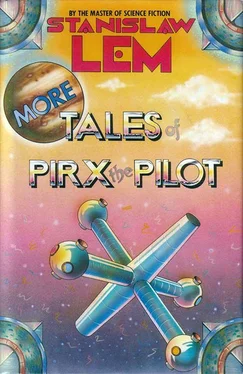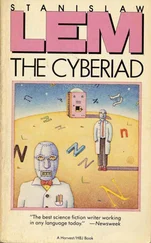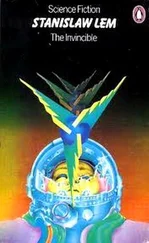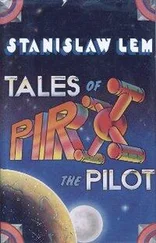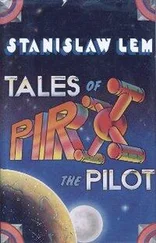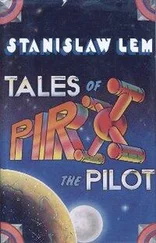Around four in the afternoon Pirx was sitting in the turret of a large caterpillar transporter, jolted by its violent motions. He was wearing a full suit, with the helmet on his knees, ready to put it on at the first sound of the alarm, and across his chest hung a heavy laser, the butt of which poked him unmercifully; in his left hand he had a map, and he used the right to turn a periscope, observing the long, spread-out line of the other transporters, which pitched and tossed like boats across the debris-strewn tracts of the Sea of Tranquillity. That desert “sea” was all ablaze with sunlight and empty from one black horizon to the other. Pirx received reports and passed them on, spoke with Luna Base 1, with the officers of the other machines, with the pilots of the reconnaissance modules, whose microscopic exhaust flames every so often appeared among the stars in the black sky; yet with all of this he still couldn’t help feeling at times that he was having some kind of highly elaborate and silly dream.
Things had happened with increasing frenzy. He wasn’t the only one to whom it seemed that Construction had succumbed to something like panic. For, really, what could one halfwit automaton do, even armed with a light-thrower? So when at the second “summit meeting,” right at noon, there began to be talk of turning to the UN, at least to the Security Council, for “special sanction,” namely permission to bring in heavy artillery (rocket launchers would be best), and possibly even atomic missiles—Pirx objected, along with others, that in that way, before they got anywhere, they would be making complete asses of themselves in front of all Earth. Besides, it was obvious that for such a decision from the international body they would have to wait days if not weeks, and meanwhile the “mad robot” could wander off God knows where. Once it was hidden in the inaccessible rifts of the lunar crust, you wouldn’t be able to get at it with all the cannons in the world; it was essential to act decisively and without delay.
It became clear then that the biggest problem would be communications, which had always been a sore point in lunar undertakings. Supposedly, there existed about three thousand different patents for inventions designed to facilitate communications, ranging from a seismic telegraph (using microexplosions as signals) to “Trojans,” stationary satellites. Such satellites had been placed in orbit last year, but they didn’t improve the situation one bit. In practice the problem was solved by systems of ultrashortwave relays set on poles, a lot like the old pre-Sputnik television transmission lines on Earth. This was actually more reliable than communication by satellite, because the engineers were still racking their brains over how to make their orbiting stations unsusceptible to solar storms. Every single jump in the activity of the sun, and the resultant “hurricanes” of electrically charged high-energy particles that tore through the ether, immediately produced a static that made it difficult to maintain contact—sometimes for several days.
One of those solar “twisters” was going on right now, so messages between Luna Base 1 and Construction went by way of the ground relays, and the success of Operation Setaur depended—to a large degree, at least—on the “rebel’s” not taking it into its head to destroy the girdered poles that stood, forty-five of them, on the desert separating Luna City from the cosmodrome near the construction site. Assuming, of course, that the automaton would continue to prowl in that vicinity. It had, after all, complete freedom of movement, requiring neither fuel nor oxygen, neither sleep nor rest; in all, it was so self-sufficient that many of the engineers for the first time fully realized how perfect was this machine of their own making—a machine whose next step no one could foresee.
The direct Moon-Earth discussions which had begun at dawn between Control and the firm Cybertronics, including the staff of Setaur’s designers, went on and on; but not a thing was learned from them that hadn’t already been said by little Dr. McCork. It was only the laymen who were still trying to talk the specialists into using some great calculator to predict the automaton’s tactics. Was the Setaur intelligent? Well, yes, in its own fashion. That “unnecessary”—and at the present moment highly dangerous—“wisdom” of the machine angered many participants in the action; they couldn’t see why in hell the engineers had bestowed such freedom and autonomy on a machine made strictly for mining tasks. McCork calmly explained that this “intellectronic redundancy” was, in the current phase of technological development, the same thing as the excess of power generally found in all conventional machines and engines: it was an emergency reserve, put there in order to increase safety and dependability of function. There was no way of knowing in advance all the situations in which a machine, be it mechanical or informational, might find itself. And therefore no one really had the foggiest notion of what the Setaur would do. Of course the experts, including those on Earth, had telegraphed their opinions; the only problem was that these opinions were diametrically opposed. Some believed the Setaur would attempt to destroy objects of an “artificial” nature, precisely like the relay poles or high-tension lines; others thought, on the contrary, that it would expend its energy by firing at whatever stood in its path, whether a lunar rock or a transporter filled with people. The former were in favor of an immediate attack for the purpose of destroying it; the latter recommended a wait-and-see strategy. Both were in agreement on one thing only, that it was absolutely vital to keep track of the machine’s movements.
Since early morning the lunar fleet, numbering twelve small units, had patrolled the Sea of Tranquillity and sent continual reports to the group defending the construction site, which in turn was in constant contact with headquarters at the cosmodrome. It was no easy thing to detect the Setaur, a tiny piece of metal in a giant wilderness of rock filled with fields of detritus, cracks, and half-buried crevices, and covered besides with the pockmarks of miniature craters.
If only those reports had at least been negative! But the patrolling crews had alarmed ground personnel several times already with the information that the “mad machine” was sighted. So far it had turned out that the object was some unusual rock formation or a fragment of lava sparkling in the rays of the sun; even the use of radar along with ferroinduction sensors proved to be of little help—in the wake of the first stages of lunar exploration and colonization, there remained upon the Moon’s rocky wastes a whole multitude of metal containers, heat-fused shells from rocket cartridges, and all possible sorts of tin junk, which every now and then became the source of fresh alarms. So much so that operation headquarters began to wish the Setaur would finally attack something and show itself. However, the last time it had revealed its presence was with the attack on the small transporter belonging to the electrical repair team. Since then it seemed as if the lunar soil had opened up and swallowed the thing. But everyone felt that sitting and waiting was out of the question, particularly when Construction had to regain its energy supply.
The mission—covering about ten thousand square kilometers—consisted in combing that area with two waves of vehicles approaching each other from opposite directions, from the north and the south. From Construction came one extended line under the command of their head technologist, Strzibor, and from the Luna Base cosmodrome came the second, in which the role of operations coordinator of both sides, working closely with the chief (Commodore-Navigator Pleydar), fell to Pirx. He understood perfectly that at any moment they could pass right by the Setaur; it might, for example, be hidden in one of those deep tectonic trenches, or even be camouflaged by nothing but the dazzling lunar sand, and they would never notice it; McCork, who rode with him as “intellectronician-consultant,” was of the same opinion.
Читать дальше
